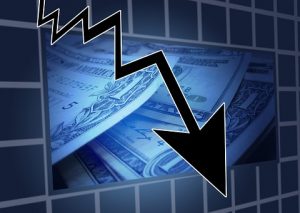
Current Market Outlook
BLOG POST: Our Current Market Outlook is “Uptrend Under Pressure” and our light is “yellow.“

They say that March comes in like a lamb and goes out like a lion. But what happens in between? As I write this from my home, outside the winds are howling at 18 mph with gusts of up to 30+! Earlier, snow was falling… horizontally. (I had planned to go into the office for a bit, but who wants to go out in this?) So goes the weather of March. More like a stampede of wooly mammoths today and just in time for the Ides.
The same can be said for the stock market. The charging elephants on Wall Street (“smart money” crowd) are accelerating their exit and are chilling most investors in the process. Winds of change are indeed blowing. And all this price damage coming just in time for quadruple option expiration Friday. A possible catalyst for a short-term upturn? More on that later in this article.
Question: Is the rest of the world preparing for war on a larger scale than Ukraine? The market seems to be suggesting that’s a growing view. Much of the recent price action in commodities and stocks points to a potential build-up of war materials. Look at steel, coal, food- Ags (including softs) and Aerospace/Defense stocks. Their recent strong, upward moves are clearly in reaction to the shameful and despicable spread of failed communism back into the Ukraine through lethal force by Putin. While many people feel that this “war trade” will reverse once a peace deal (or at least a ceasefire and stoppage to the advance) is struck, which may prove to be accurate in the short run, the winds of war may not be limited to Europe.
There are additional clues regarding another possible war. Take a look at the carnage in Chinese stocks. Absolute investor distress.
As a sidenote, have you seen what has happened to the Russian stock market? And to the ETF’s that invest in it? You need only look at the chart of RSX to get the picture. Moral of the story: The stock markets of hostile nations get treated hostilely by investors.
Back to China. Bring up the weekly charts of FXI, CAF, ASHR, KALL, CHIR, and CN. Fear on display. (Or is it knowledge?) That fear has started to spill over to many other Asian stock markets. Panic seems close to setting in. (Note: None of the sectors or symbols mentioned in this article are to be taken as an investment recommendation.)
In our last blog post, we noted the CCP’s appetite for “Taiwanese takeout.” This is a real and present danger. The poisoning spread of communism is visible in our day. The nations that subject its citizenry to it are the “free-world’s” archenemies. Talk about a possible evil axis: China, Russia and North Korea. Oh, and let’s not forget about Iran.
So what do we do? We pray. We share the evidence with our oblivious, or apathetic family members, co-workers, and neighbors. We vote – for strong leadership and experience. Putting the world’s need for peace before our own social-agenda’s.
Here’s a resource for you to consider.
https://www.theepochtimes.com/how-the-specter-of-communism-is-ruling-our-world
Our Current Market Outlook remains “Market in a Correction” with a red light. The “Core Four” shows 1 green and 3 red lights through today’s action (see top of page) with the VIX still casting the tie-breaking vote.
Keep an open mind to the likelihood of a fast and violent “reversion to the mean” up-move in the weeks ahead. Wall Street likes its fees and nowhere is that more obvious than in the apparent manipulation of stock prices heading into the end of calendar quarters. March 31st is approaching… go out like a lion? Probably so. But if the CCP immediately follows Russia’s example, then all bets are off.
While the internals, “the math of the market,” have been awful for many weeks (as our “Core Four” caught very early in the down move), a couple of small technical “green shoots” have appeared.
Here’s where it gets difficult. We don’t make predictions, but we do analyze the odds of possible outcomes based on market history and current technical action. The market is not as random as you may think it is. It is very efficient (in the long run) and has certain predictable outcomes based on the current inputs. “Money goes where it’s treated best” is a fact on Wall Street… and on your street.
We agree with Scott St. Clair of IBD/MarketSmith, who shared he feels the Nasdaq’s bear market started nearly a year ago. It is clearly evidenced by the spectacular price implosions of around 50% to 85% in dozens and dozens of former growth leaders that surged out of the CCP induced Covid-19 pandemic bear market. Big-tech stocks are now also acting waterlogged. History shows that when the “last-standing leaders” finally start to crack, their sharp down moves may usher in a meaningful tradeable, short-term bottom.
Back to the green shoots.
While the textbook climatic reading on the P/C ratio or the TRIN have not happened yet, there has been an important development in the Bulls/Bears ratio, as it has moved into a negative reading, which is seen as a bullish development. (Part of the lone green signal in our “Core Four” at the top.) Additionally, the VIX index has a lower price high (so far!), reflecting a slight reduction in fear, or investor hedging. Having said that, our own research has found that historical market bottoms feature rapid price declines that are accompanied by major spikes in the Put/Call ratio and the TRIN indicator. Again, neither have happened yet in this down move.
The definition of a bear market is a decline of 20% or more from a recent price peak of a major index. The Nasdaq is already in one. Contrary to popular belief, the current Nasdaq bear market is not a result of Russia’s abominable invasion of Ukraine, but rather a direct result of the Federal Reserve Board’s unfolding campaign to hike interest rates due to rampant inflation. Sure, the war may have accelerated it a bit, but it was already in motion and inevitable.
Speaking of the Fed, their all-important interest rate hike announcement is on Wednesday the 16th at 2pm EDT. Sure to be a major market mover. Watch out if they do a ½ % hike! FYI: The mortgage rate market seems to be leaning that way.
Our strategies have held up extremely well for our clients, and we praise God for that! Positions in oil & gas, gold and silver and interest rate ETF’s have performed as expected. Cash has also been king.
Many investors are scrambling to figure out what is next. Bear markets are usually a function of price and time. Typically, declines of 20-35% (many times it has been worse) over a period of 6 to 18 months (The Covid dive was 1 month+ and the Y2K tech bubble lasted nearly 3 years) are needed to create a launching pad for the next economic boom. Speaking of the 2000-02 bear market, that is an excellent example of what can happen when the Fed embarks on a dramatic rate hike campaign after a ridiculous run up in “technically rich” but fundamentally poor growth stocks, much like what has transpired the past two years.
An interesting fact about that “Tech Wreck” bear market: according to a slide shared March 4th in a MarketSmith podcast by Scott St. Clair, between April 2000 and August 2002 that bear featured 15 significant price rallies in the Nasdaq ranging from 10.8% to 51.3%. The average gain was 23%! And yet, every one of those rallies failed. Perhaps, there is a period ahead for investors that features many tradeable rallies within the context of an interest rate induced bear market. Traders and investors take heed.
One last possible green shoot, or at least an idea to keep an eye on as a market tell. Banks. Typically, banks experience a growth in earnings as interest rates move up across the yield curve, especially if the long end widens out. The result is their N.I.M. (net interest margin) expands and bigger profits fall like manna to their bottom line. Case in point: On Friday, in the Investor’s Business Daily “General Market Indicators” page, 8 of the top 10 “IPO Best Price Change EPS & RS rating 80 or more” were small to mid-sized banks. We have observed similar action in that segment on several days over the last few weeks. Why is this a possible green shoot? Because recession is bad for banks. Inverted yield curves often precede a recession. But, if the bank stocks hold up and even eventually start to lead, that can be seen as a good sign for the economy. Keep it on your radar.
Please note we have recently discovered that we are having technical issues with our “Outlook Updates” archive dropdown feature to the right of our posts. Until further notice, please use the links at the bottom left of each post to access prior posts.
Game plan: Keep your powder dry and refresh your watchlist with resilient sectors and their leaders. Expect volatility and be ready to act boldly if opportunities arise. Wait for the Fed announcement on Wednesday before allocating large amounts of capital. Pray for wisdom.
Have a Triumphant day! ®
The information in this article is based on data obtained from recognized services and sources and is believed to be reliable. Any opinions, projections or recommendations in this report are subject to change without notice and are not intended as individual investment advice. Not to be used as legal or tax advice. ©2022 Triumphant Portfolio Management, LLC.
The Latest

BLOG POST: Our Current Market Outlook is “Uptrend Under Pressure” and our light is “yellow.“

Where Are Woodward and Bernstein When We Need Them? This article was written by Newt

A poem about a modern day Pig in a Poke, being “woke” and going broke.
Triumphant Truth
You’re not here by accident. God loves you. He wants you to have a personal relationship with Him through Jesus, His Son. Triumphant strives to honor the Lord and bear witness to His love and mercy by serving our clients with disciplined, proactive wealth management.
14803 Forest Rd.
#1147
Forest, VA 24551
Request a Triumphant newsletter to receive updates on the markets and Christ-centered investing.
Send mail to:
14803 Forest Rd. # 1147
Forest, VA 24551
Request a Triumphant Newsletter to receive updates on the markets and Christ-centered investing.
This information is not intended to be a substitute for specific individualized advice. The TPM strategies cannot assure a profit nor protect against loss. Inherent limitations and market conditions may affect the performance of portfolios in any given market environment. Past performance does not guarantee future results. Investors should consider the investment objectives, risks, charges, and expenses associated with any investment strategy.
Advisory Services Through Sowell Management, a Registered Investment Advisor | Privacy & Disclosures | © 2025 Triumphant Portfolio Management, LLC